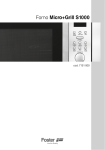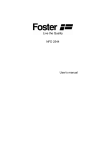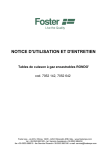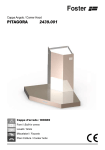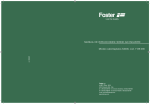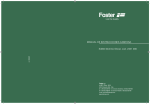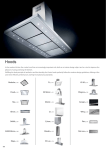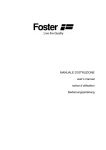Download Foster Faust 90
Transcript
7167-042 “Faust 90” multifunctional oven Installation, operating and maintenance manual GB 18 PRECAUTIONS FOR SAFE OPERATION • This manual constitutes an integral part of the appliance; it must be stored intact for future reference for the entire oven lifecycle. Carefully read this manual prior to using or installing the appliance. • This oven is designed for domestic use only and is intended for cooking and warming foodstuffs. Any other use (e.g. warming of the room) constitutes improper use and is dangerous. The manufacturer shall not be held liable for any consequences resulting from alternative use of the oven. • The various packaging components must not de dispersed into the environment, but disposed of in compliance with the legislation in force concerning waste disposal. • Installation must be carried out by qualified personnel in conformity to the regulations in force. • In the event that the appliance malfunctions, disconnect it from the power supply and contact the nearest Foster technical assistance centre. Observe the following for correct use of the oven: - This appliance is intended for use by adults - keep children out of reach. - Do not introduce inflammable objects in the oven as these may cause fire. - The appliance generates heat, therefore limit contact with its outer surface and absolutely avoid touching the internal parts. - Grip the handle in the centre to open the door correctly. - Always use oven gloves when introducing or removing foodstuffs into/from the oven. - Do not obstruct the oven's ventilation and heat dissipation openings. - Do not place heavy objects on the open door as these could damage the hinges. - Do not hang any heavy object from the oven door handle. - Do not pull on the power cable to unplug the appliance. Observe the following to save energy: - Pre-heat the oven only for the time strictly required. - Use dark-coloured oven cookware items as they absorb heat more effectively. - Open the oven door only when strictly necessary so as to avoid dispersing heat. - Keep the gaskets clean and fully efficient in order to prevent heat dispersal. - Always make sure the oven is turned off after use. THE MANUFACTURER DECLINES ANY CIVIL AND CRIMINAL LIABILITY SHOULD THE ELECTRICAL CONNECTIONS NOT BE CARRIED OUT IN CONFORMITY TO THE LAWS IN FORCE AND THE INSTRUCTIONS CONTAINED HEREIN. 19 INSTALLATION INSTRUCTIONS Installing the built-in oven into the cabinet The oven can be installed either on column cabinets or beneath cabinet worktops. The cabinet recess must have the following dimensions: 865x467 mm. An opening must be cut into the back of the oven cabinet or support shelf (towards the rear) to ensure adequate air flow and ventilation for the oven to cool during operation. Make sure that the oven is safely installed in the cabinet. Use the 4 screws (A) to secure the oven. Cabinet features The cabinet must have the following features: • The cabinet and related components must be able to withstand a temperature of 150°C without deforming and/or surface defects appearing. • The cabinet must not interfere with the passage of electrical wiring. • The cabinet housing the oven must have a load capacity of 70 kg. Electrical connections IMPORTANT: • The electrical connections must be carried out by a qualified and/or authorised electrician only. • The electrical connection must be carried out in conformity to the European regulations in force. • The electrical connection required is a single-phase 220-240 V, 50-60 Hz type connection (check the product's rating plate regarding the correct supply voltage and frequency). 20 IT is mandatory to earth the appliance: • If the appliance is directly connected to the mains electricity, an omnipolar switch with contact gap of at least 3 mm - able to withstand the oven's power output must be installed between the oven and power socket. • The earth wire must by no means be interrupted by the omnipolar switch. Always ensure that the oven is disconnected from the power supply before effecting maintenance work and/or adjustments. The oven may be supplied without a plug fitted on the power cord. If this occurs, choose a plug that can withstand the oven's maximum power output. Make sure that the earth wire (yellow/green) is properly connected to the relative plug pin. Follow the steps below when connecting or replacing the power cable: • Disconnect the appliance or the power supply. • Open the terminal board cover. • Connect the ends of the power cable - remember that the earth wire is identified by the yellow/green jacket. If using a BS 1363-approved 13 A plug, apply a 13 A fuse. • The power cable must be secured by the cable clamp on the terminal board to prevent it from turning and/or detaching. No point of the cable must be exposed to temperatures exceeding 75 °C. • The plug connecting the appliance to the mains electricity must be suitable for the oven's power output. Moreover, the plug must be easily accessible once the oven has been installed. An omnipolar switch with a contact gap of at least 3 mm must be installed in the event of a direct connection to the mains electricity. morsettiera bloccacavo terra terminal board cable clamp earth 21 WARNING: use a flexible three-wire cable - type H05RR-F (3x1.5 mm). 22 OPERATING INSTRUCTIONS Control panel A = ON/OFF (power indicator light) B = ON/OFF (thermostat indicator light) C = electronic programmer (5 buttons) D = oven temperature thermostat knob E = commutator or function selector knob IMPORTANT: prior to first use, turn on the oven at maximum power and operate it for maximum 1 hour while empty. Aerate the room well and open the kitchen windows if necessary. This ensures that any combustion fumes of production residues such as grease, oil and processing resin can escape. ON/OFF (power indicator light) When turned on, it indicates that the oven is electrically powered. ON/OFF (thermostat indicator light) Indicates the turning on/off of the heating elements to maintain the selected cooking temperature. 23 Electronic programmer The clock shows the time up to 23 h : 59 min. End-of-cooking time up to 23 h : 59 min., timer up to 23 h : 59 min., cooking time of 10 h. Functions Cooking time C, end-of-cooking time S, time, timer B, minus -, plus +, manual selection C - S, automatic programme A, manual mode . Display 4-digit, 7-segment display for the time of day. Allows for checking the remaining cooking time. Setting the time Select a function by pressing the relative button and set the time using buttons + and -. Plus/minus (+ / -) buttons Pressing button + increases the time while pressing - decreases it. Scroll the digits rapidly by pressing and holding either button. Setting the clock Select the “set clock” function by simultaneously pressing C and S while setting the time with buttons + and -. This operation cancels the previously set cooking time programme and disengages the manual mode. Manual operation mode This function allows for using the oven continuously. Simply press buttons C and S simultaneously on the electronic programmer. The control relay will activate. The letter “A” (automatic) will disappear from the display and the pot symbol C will appear. Any previously set programme will be cancelled. Semi-automatic operation mode with end-of-cooking time Select function C and set the end-of-cooking time using buttons + and -. The symbol “A” and the pot symbol C will appear on the display, thereby activating the power switch. When the clock reaches the programmed end-of-cooking time, a buzzer sounds and the symbol “A” will flash intermittently; symbol "C" and the heating element will then turn off and the oven will stop operating. 24 Automatic operation mode Select function C and set the cooking time using buttons + and -. The symbol “A” and the pot symbol C will appear on the display, thereby activating the power switch. Select function S and the end-of-cooking time will appear. Set the end-of-cooking time using buttons + and -. The power switch and pot symbol will disengage. The pot symbol will reappear when the clock reaches the programmed start-of-cooking time. At this point, insert the foodstuff in the muffle, select the desired cooking function and programme the cooking temperature. At the end of the automatic mode, the symbol “A” will flash. A buzzer will sound and the power switch and pot symbol will disengage. Timer Select button B and set the required time using buttons + and -; the bell symbol will appear on the display. A buzzer sounds once the programmed time is reached. Buzzer The buzzer (1 Hz, intermittent) sounds for 7 minutes at the end of the programmed time. Any button can be pressed to stop the buzzer. While the buzzer sounds, the frequency of the sound can be adjusted by pressing and holding - (“minus” button). Three different frequencies can be selected. Programme start and check Each pre-set programme activates only once the cooking time has been set. The start time can be checked any moment by selecting the previously programmed function. Identifying programming errors Incorrect programming occurs if the time of day falls within the programmed cooking period - i.e. between the start and end of cooking time. In the event of incorrect programming, a buzzer sounds and the symbol “A” will flash. The error can be rectified by modifying one of the two cooking times. Cancelling a programme A cooking programme can be cancelled by selecting the manual mode. Likewise, when a pre-set programme terminates autonomously, it is automatically cancelled for future operations. 25 Oven temperature thermostat The oven temperature thermostat controls the desired cooking temperature for all the oven's operating selections. The heating elements turn on/off to maintain the programmed temperature. Commutator or oven function selector This commutator activates the desired cooking function. The illustration below shows the heat source and heat distribution for each selected operating mode. The lower and circular heating elements are housed in the bottom and rear end of the muffle respectively. The heating elements turn on/off automatically to maintain the desired cooking temperature. Oven lamp Use this function to turn on the oven lamp. The lamp remains lit with the other functions as well. Regular static cooking Use this function for regular cooking or for roasting. The upper and lower heating elements heat the air. 26 Bottom-end cooking Use this function to roast foodstuffs from below. The intense heat generated is ideal for roasting meat that is not particularly tender. Top-end cooking Use this function to roast foodstuffs from above. The intense heat generated is ideal for cooking and browning foodstuffs. Grill Use this function for grilling foodstuffs. Select the grill function on the commutator and position the thermostat on the maximum temperature setting. Pre-heat the muffle before introducing the foodstuff. Use the grill function for maximum 15 minutes and always with the oven door open. WARNING: accessible parts may overheat while the grill mode is activated. Keep children at a safe distance. Rotisserie grill Use this function for grilling with the aid of a spit. It is advisable to pre-heat the oven using the grill mode prior to using this function. Insert the spit with the foodstuff in the appropriate hub then lay it on the spit support. Position the drip pan beneath the foodstuff. Remember to remove the spit grip prior to the start of cooking. 27 Ventilated grill Use this function to grill with the addition of hot air. Intensive cooking with hot air Use this function to roast or cook foodstuffs with the aid of hot air. The upper-end and lower-end cooking with hot air produces a crisp finish on foodstuffs. Intense cooking with hot air Use this function to achieve uniform cooking. The ideal cooking mode for baking cakes, bread and other large-sized foodstuffs. Thawing and drying Use this function to accelerate thawing and/or drying of foodstuffs to be cooked, with the aid of forced air flow. 28 Oven grid positions for specific cooking needs • Frozen cakes, long roasts, turkey, cakes, well-done steak: positions no. 1 and 2 from bottom. • Cakes, sandwich bread slices, toasts, foodstuffs in saucepans, whole-grain bread, meat: position no. 2 from bottom. • Biscuits, thin-sliced meat: position no. 3 from bottom. • For browning with the grill mode, use position no. 3 from bottom. WARNING: the oven may reach very high temperatures during operation. Be careful not to touch the heating elements inside the oven. 29 MAINTENANCE INSTRUCTIONS Cleaning the oven Cleaning safety Turn the oven off and wait until all the heating elements have cooled down before touching or cleaning them. Clean the appliance with care. Cleaning the oven surface Clean using a damp cloth wetted with non-abrasive detergent then wipe with a soft dry cloth. Stainless steel surfaces with crusty residues must only be cleaned using a plastic scraper or sponge wetted with vinegar and warm water. WARNING: do not use steam-cleaners for cleaning any part of the oven. Oven door Follow the instructions below for removing and reinserting the oven door. Removing the oven door Open the oven door fully. Lift the hinge hook and shift it into the indentation on both hinges. This will prevent the hinges from closing suddenly while removing the door. Grip the door by the sides towards the hinge area. Raise the door by a few centimetres (the spring will offer some resistance due to the locked hinge). Once the door has been sufficiently raised, the hinges can be dislodged from their housings. Remove the hinges from the openings on the door frame. Lower the hinge hook after inserting the door Lift the hinge hook and shift it into the locking indentation to remove the oven door Hinge hook Reinserting the oven door Grip the door by the sides towards the hinge area and insert the hinges into the openings of the oven's front frame. Disengage the locking hooks while keeping the door fully open. 30 Lift the oven door and ensure that is has been properly inserted and aligned with the side edges. WARNING: do not remove the locking hooks from their housing once the door has been removed. Do not close the hinges without the weight of the door countering them, or else the powerful springs will cause the hinges to close violently. CAUTION: do not lay heavy objects on the door or stand on it. This may cause the door to break or harm the user. Moreover, do not use the oven until the door has been properly reinserted. Removing the internal glass plate of the oven door (4 screws) Replacing the oven lamp WARNING: in order to prevent electric shocks and/or harm to persons, read and follow the procedure below. Prior to replacing the oven lamp, verify that the mains electricity has been disconnected by pressing the mains switch. Make sure that the oven and lamp are both cold. Next, unscrew and remove the lamp cap “A”. Do not touch the hot lamp with a damp cloth as the lamp itself may shatter. Replace the lamp with a 25 W lamp suitable for household appliances (for 220-240 V AC operation). If the lamp cap is damaged or broken, do not use the oven until it has been properly and safely replaced or reinserted. 31 Spare parts Only authorised spare parts may be used for carrying out technical interventions on the appliance. All repairs or technical interventions must be carried out by authorised and qualified personnel. Spare parts can be ordered by contacting the nearest authorised technical assistance centre (consult the list on the "warranty guide") and indicating the following data: • Oven serial number and model number, which can be found on the label placed on the lower front side of the muffle. • Details of the dealer from which the oven was purchased. 32 OVEN SPECIFICATIONS Electrical data Voltage Total power output Upper heating element Grill heating element Lower heating element Circular heating element Oven lamp Oven fan Tangential oven fan 220-240 V, 50-60 Hz 2.6 kW 0.8 kW 1.8 kW 1.2 kW 2.5 kW 2 x 25 W 25 W 25 W Muffle working dimensions Height Width Depth Grilling surface 305 mm 580 mm 410 mm 700 cm2 Energy consumption necessary to reach 200°C necessary to maintain 200°C Total consumption power 0.60 kW/h 0.81 kW/h 1.41 kW/h General features • Foster model no.: 7167-042 • front external dimensions: 895x470 mm • recess dimensions: 865x467 mm • standard features: grid, enamelled drip pan, spit • 8 operating programmes • tangential fan • electronic programming of start and end of cooking time with digital display • working volume: 73 litres • energy class: A • triple-glazed door This oven is manufactured in conformity to the following European directives: - 2002/40/EC (Energy Labelling Directive) - 2004/108/EC (Electromagnetic Compatibility Directive) - 2006/95/EC (Low-Voltage Directive) 33 END-OF-LIFE PRODUCT DISPOSAL This product conforms to European Directive 2002/96/EC. The crossed-out dustbin symbol appearing on the appliance indicates that the end-of-life product must be treated separately from domestic household waste and delivered to a separated waste collection facility for electric and electronic equipment, or returned to the dealer when purchasing a new appliance of the same kind. The user is responsible for delivering the end-of-life product to an appropriate waste collection facility and, should this not occur, will be subject to the relative penalties specified by the waste disposal legislation in force. Proper separate disposal of the decommissioned product and its eco-compatible recycling, treatment and scrapping contributes to preventing possible negative effects on the environment and human health, and favours the recycling of the materials comprising the product. For more detailed information on the available waste collection systems, contact your local waste disposal service or the dealer from which the product was purchased. Foster S.p.A. via M.S. Ottone, 18/20 – 42041 Brescello (RE) – Italy www.fosterspa.com [email protected] After-sales service: Tel. +39 0522-684450; Fax +39 0522-686019, [email protected] Spare parts service: Tel. +39 0522-684300; Fax +39 0522-684300 34

















